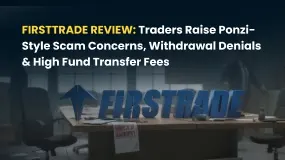简体中文
繁體中文
English
Pусский
日本語
ภาษาไทย
Tiếng Việt
Bahasa Indonesia
Español
हिन्दी
Filippiiniläinen
Français
Deutsch
Português
Türkçe
한국어
العربية
Why Studying A Lot Doesn’t Work | When Technical Analysis Fails
Abstract:Technical analysis is the go-to toolkit for countless investors. Candlestick patterns, moving averages, MACD signals, Elliott Waves—you name it, there’s a chart or model for it. Many spend years perfecting their craft, poring over price patterns and back testing strategies. Yet, despite all this effort, a large number still lose money. The reason? It’s not the tools as they’re merely instruments. It’s the human behind them that falters. In particular, wishful thinking and emotional bias often sabotage disciplined execution.

Technical analysis is the go-to toolkit for countless investors. Candlestick patterns, moving averages, MACD signals, Elliott Waves—you name it, there‘s a chart or model for it. Many spend years perfecting their craft, poring over price patterns and back testing strategies. Yet, despite all this effort, a large number still lose money. The reason? It’s not the tools as they‘re merely instruments. It’s the human behind them that falters. In particular, wishful thinking and emotional bias often sabotage disciplined execution.

1. Its a Game of Probabilities, Not Certainties
At its core, technical analysis is probabilistic. Indicators like support and resistance levels or moving average crossovers rely on historical patterns, not guaranteed outcomes. But markets are driven by human behaviour, which is always irrational. Greed, fear, and hope can disrupt even the most well-defined technical setup.
Take a textbook breakout, for instance. A stock breaks through a neckline, indicating bullish momentum. But just as traders pile in, major players might deliberately reverse course, triggering a sharp decline. In such moments, textbook theory collides with market reality.
2. The Perils of Overfitting
Many traders fall into the trap of over-optimising their indicators, tweaking variables in search of the elusive ‘perfect’ signal. But markets evolve. A strategy that performed well in a past bull run might be obsolete in a downturn. The 2015 Chinese stock market crash was a harsh reminder: countless traders believed in the mantra “a bull market never tops” until they were blindsided by a brutal collapse.
3. Black Swan Events Ignore Your Charts
Technical analysis falters in the face of unpredictability. Policy shifts, corporate fraud, geopolitical conflicts will not be priced into your moving averages. When U.S. crude oil futures turned negative in 2020, no chart could have seen it coming. In such moments, statistical patterns become irrelevant.

While technical indicators provide signals, the real battleground is psychological. Traders often know what to do, but fail to act.
1. Ignoring Stop-Loss Signals
The discipline to cut losses is foundational. Yet many traders, driven by the hope of a rebound, delay action. “Just wait, itll bounce back,” they say. A minor dip deepens into a painful loss. Studies show that over 90% of retail investor losses stem from an inability to exit losing positions in time.
2. Greed Overrides Exit Strategies
On the flip side, profitable trades are held too long. Technical signals advise caution with divergences, fading volume, but greed whispers, “It can go higher.”
3. Averaging Down into the Abyss
Technical discipline advises trading with the trend. But the urge to lower ones average cost leads traders to buy more as prices fall. The result? Compounding losses.
4. The Allure of Frequent Trades
Technical analysis should enhance precision, not encourage impulsivity. Yet overconfidence often leads to hyperactive trading. Ironically, higher trade frequency correlates with greater losses.
In summary, technical analysis is a sharp blade as it can be capable, precise, and powerful. But in the hands of a trembling trader ruled by hope, it becomes dangerous. Ultimately, the most successful market participants are not the most technically proficient, but the most disciplined.
Markets reward those who master their emotions, not those who master their charts.

Disclaimer:
The views in this article only represent the author's personal views, and do not constitute investment advice on this platform. This platform does not guarantee the accuracy, completeness and timeliness of the information in the article, and will not be liable for any loss caused by the use of or reliance on the information in the article.
Read more

Firsttrade Review: Traders Raise Ponzi-Style Scam Concerns, Withdrawal Denials & More Issues
Have you lost all your capital while trading via Firsttrade? Does the US-based forex broker disallow you from withdrawing funds? Do you have to pay massive fees when transferring funds? Does your trade get affected because of frequent malfunction in the trading app? These have been haunting many traders at Firsttrade. Consequently, many of them have raised complaints online. In this Firsttrade review, we have shared such complaints. Keep reading to know about them.

Defcofx Review: Spread Manipulation & Poor Customer Support Outrage Traders
Does the poor customer support service leave you stunned when trading via Defcofx? Do you receive blunt, negative responses from the support team on several trading queries? Does the Saint Lucia-based forex broker pile on the losses for you by manipulating forex spread charges? In this Defcofx review, we have shared some complaints made against the broker. This will further answer your question: Is Defcofx real or fake?

How to Add and Take Out Money from Amillex Broker: A Complete Guide
Good money management is the foundation of successful trading. Learning how to make an Amillex Broker deposit and withdrawal is your first step toward trading with confidence. We know that for any trader, moving money must be safe, fast, and simple. This guide gives you a complete, step-by-step walkthrough for all amillex broker funding activities, so you can manage your account with total clarity. The whole process, from your first deposit to taking out profits, is made to be simple. You start by logging into your secure client area, picking a payment method that works for you, choosing the amount, and confirming the transaction. This guide will cover detailed deposit instructions, a full breakdown of withdrawal steps, a comparison of available payment methods, and a detailed look at the security measures protecting every transaction.

FCA warning: These Firms are on the list
In 2025, the UK’s Financial Conduct Authority (FCA) intensified its crackdown on financial misconduct, issuing a series of fines and public warnings against both major institutions and forex brokers. This article provides an updated list of brokers, banks, and financial platforms that have been recently fined, banned, or listed on the FCA’s warning list, highlighting the importance of transparency and investor protection in the UK’s financial market.
WikiFX Broker
Latest News
How to Add and Take Out Money from Amillex Broker: A Complete Guide
FCA warning: These Firms are on the list
Ponzi Scheme Operator Sentenced to 14 Years in Western Australia
Dubai VARA Warns Against Vesta Investments
Don’t Get Scammed: A Roundup of Common Online Fraud Tactics in Forex
T4Trade broker Review 2025: Is T4Trade Regulated?
Chicago PMI Beats But Remains In 'Contraction' For Second Straught Year
Annual Sales Of New Vehicles Expected To Hit Only 15.7 Million Units: Cox
MH Markets Overview: Fees, Platforms, and Regulation
Is MultiBank Group Legit or Scam? A 2025 Regulation Review
Currency Calculator



